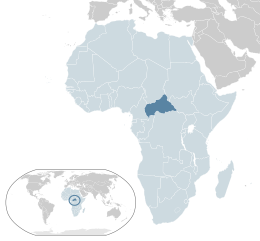共享资源:各地著作权法规/中非共和国
|
著作权法规: 中非共和国 快捷方式: COM:中非共和国 | |
 | |
 | |
| 保护期限 | |
|---|---|
| 标准 | 作者逝世+50年 |
| 照片 | 创作年份+20年 |
| 匿名 | 创作或发表年份+50年 |
| 视听作品 | 创作或发表年份+50年 |
| 应用艺术 | 创作年份+20年 |
| 其他 | |
| 全景自由 | For films, radio and television broadcasts |
| 一般授权条款标签 | {{PD-Central African Republic}} |
| 协议 | |
| 伯尔尼公约 | 1977年9月3日 |
| 班吉协定 | 1982年2月8日 |
| 世界贸易组织成员 | 1995年5月31日 |
| 乌拉圭回合协议法案回溯日期* | 1996年1月1日 |
| *只要一个作品在美国可以受版权保护,在1928年12月31日之后发表,并在来源国的URAA日期受版权保护,那么它通常会在美国受保护。 | |
This page provides an overview of copyright rules of the Central African Republic (CAR) relevant to uploading works into Wikimedia Commons. Note that any work originating in the Central African Republic must be in the public domain, or available under a free license, in both the Central African Republic and the United States before it can be uploaded to Wikimedia Commons. If there is any doubt about the copyright status of a work from the Central African Republic, refer to the relevant laws for clarification.
管辖法律
France created the Ubangi-Shari territory in 1894 and ruled it as a colony until 1960, when it became fully independent as the Central African Republic.
The Central African Republic has been a member of the Berne Convention since 3 September 1977, the Bangui Agreement since 8 February 1982 and the World Trade Organization since 31 May 1995.
As of 2018 the World Intellectual Property Organization (WIPO), an agency of the United Nations, listed Ordinance No. 85.002 of January 5, 1985, on Copyrights as the main copyright law issued by the Executive of the Central African Republic.[1] WIPO holds the text of this law in their WIPO Lex database.
一般规则
Under Ordinance No. 85.002 of 5 January 1985,
- The author's rights last for their lifetime and for 50 years counting from the end of their year of death, or in the case of collaborative works from the end of the year of death of the last surviving author.[85.002 Article 40]
- For cinematographic, radiophonic and audiovisual works, protection lasts for 50 years from when it was lawfully made available to the public, or for 50 years from creation if it was not published within 50 years.[85.002 Article 40 (1)]
- Works owned by a legal entity, anonymous and pseudonymous works and posthumous works are protected for 50 years from being lawfully made available to the public.[85.002 Article 41]
- Photographs and works of applied art are protected for 20 years from creation.[85.002 Article 40 (2)]
- Laws, official texts of administrative or judicial nature, or the official translations thereof are not subject to copyright.[85.002 Article 10]
民俗:非自由
参见:共享资源:付费公有领域
Folklore belongs to the national heritage. It includes literary and artistic works created by national communities and transmitted from generation to generation. Public representation, performance or direct or indirect recording of folklore for profit requires authorization from the office responsible for copyright and payment of a royalty. The proceeds will be used to support cultural and social activities to the benefit of the authors.[85.002 Article 9]
不受保护
参见:共享资源:不受保护
Article 10 of the 1985 law states that protection does not apply to laws, judicial or administrative decisions or official translations of these texts, or to news of the day published, broadcast by radio or television, or communicated in public.[85.002 Article 10]
货币
参见:共享资源:货币
![]() 可以. Bank of Central African States, which issues Central African CFA franc used in Central African Republic, is based in Cameroon. Article 3c of the main IP law of Cameroon, the 2000 Copyright law, explicitly excludes banknotes and coins from copyright protection.
可以. Bank of Central African States, which issues Central African CFA franc used in Central African Republic, is based in Cameroon. Article 3c of the main IP law of Cameroon, the 2000 Copyright law, explicitly excludes banknotes and coins from copyright protection.
Please use {{PD-CA-CFA-franc}} for Central African CFA franc images.
全景自由
参见:共享资源:全景自由
![]() 不可以. For photographs, drawings, paintings etc. of protected works of art or architecture.
不可以. For photographs, drawings, paintings etc. of protected works of art or architecture.![]() 可以 for films, radio and television broadcasts of protected works if permanently in a public place or included only incidentally.
可以 for films, radio and television broadcasts of protected works if permanently in a public place or included only incidentally.
Chapitre II: Limitation permanente of the 1985 law includes the following:
- Article 11 allows copying, performance or broadcasting of protected works for non-commercial private or family use, or for scholarly or religious use.
- Article 14 allows reproduction and communication to the public of literary, artistic or scientific works when reporting a news event by photography or film to the extent necessary to convey the information.
- Article 15 allows reproduction for cinematography, radio or television broadcasting of works of art or architecture if placed permanently in a public place or if its inclusion is accessory or incidental to the main subject.